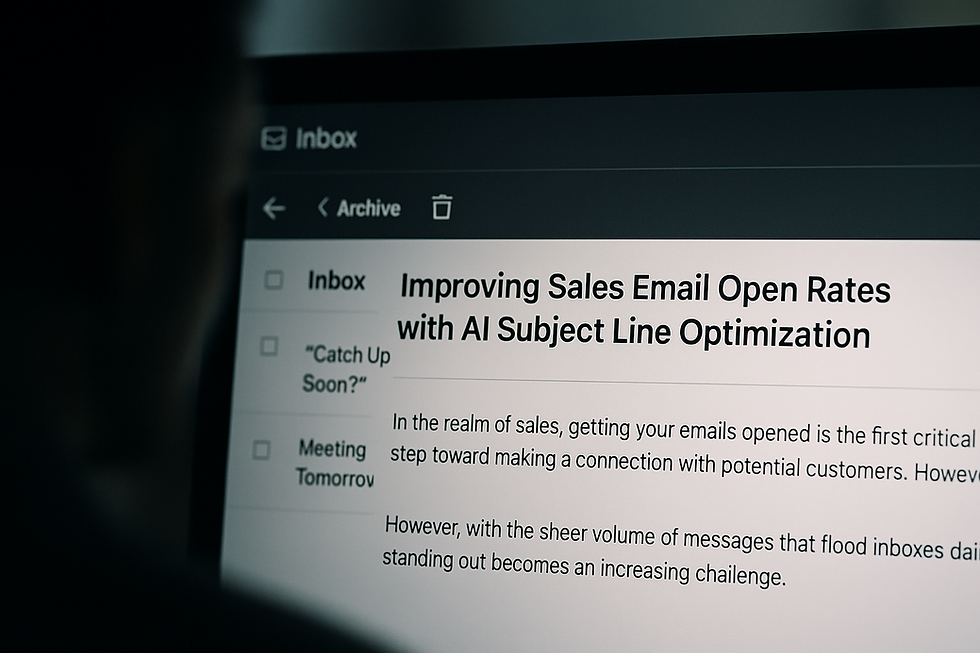How AI Detects and Removes Ineffective Sales Messaging
- Muiz As-Siddeeqi

- Aug 19
- 5 min read

How AI Detects and Removes Ineffective Sales Messaging
They Didn't Reply… But Why?
Let’s be honest. That sales email you crafted so carefully? The one with the “perfect” subject line, the bold CTA, the enthusiastic pitch?
It got ignored. Deleted. Or worse—flagged as spam.
And the most painful part?
You don’t even know why.
Because ineffective sales messaging hides in plain sight. It looks convincing, sounds enthusiastic, but still underperforms. The real tragedy? You keep sending variations of the same message, never realizing the fault lies not in the hustle—but in the message itself.
This is where AI for Ineffective Sales Messaging doesn’t just help—it rescues.
We're not throwing buzzwords. We’re diving headfirst into real, documented, jaw-droppingly powerful ways AI is scanning, evaluating, and eliminating ineffective sales messaging across industries.
We’re talking billions of data points. Real companies. Real case studies. And real transformations.
Bonus: Machine Learning in Sales: The Ultimate Guide to Transforming Revenue with Real-Time Intelligence
What Does “Ineffective” Actually Mean in Sales Messaging?
Before we even talk AI, let’s rip off the Band-Aid.
Ineffective sales messaging isn’t just about poor grammar or boring language.
It includes:
Messages that get high opens but zero replies.
Messages that drive clicks but no conversions.
Messages that “sound good” but trigger unsubscribe.
Messages that fail to emotionally connect.
Messages that deliver the wrong offer to the wrong persona at the wrong time.
In the words of McKinsey, over 71% of consumers expect personalization, and 76% get frustrated when they don’t receive it [McKinsey, 2021 Report on Personalization].
That frustration? It lives inside ineffective messaging.
The Painful Reality: Most Sales Messaging Doesn’t Work
In 2024, Salesloft analyzed over 162 million emails sent through its platform. Guess what they found?
Average open rates: 28%
Average reply rates: 8.5%
Average conversion rates: 1.3%
[Source: Salesloft Sales Engagement Benchmarks Report 2024]
That means 98.7% of all messaging fails to convert.
So where do things go wrong?
And more importantly—how can AI fix it?
The New Era: AI Doesn’t Just Guess—It Learns What Works
We’re officially in an age where AI can:
Track and understand the emotional tone of your messaging.
Detect passive vs. active voice shifts and correlate them with response patterns.
Compare your email structure with millions of high-performing sequences.
Evaluate linguistic patterns that trigger spam filters.
Identify which phrases correlate with high reply rates based on industry, season, and persona.
In other words: AI doesn’t guess what’s wrong—it knows.
What Powers AI’s Ability to Detect Bad Messaging?
Let’s break down the real technologies behind this revolution.
1. Natural Language Processing (NLP)
NLP allows AI models to understand semantics, context, tone, and structure of your message.
Tools like OpenAI’s GPT-4o and Google’s BERT aren’t reading your messages like humans—they’re reading them like machines on steroids.
They analyze:
Word-level sentiment
Sentence structure complexity
Persuasion indicators
Contextual ambiguity
NLP is how AI knows if your message “sounds robotic,” “feels pushy,” or “lacks clarity.”
2. Emotion Detection Algorithms
Yes, AI now reads emotions—really.
AI-powered platforms like Symanto and Affectiva (used by global brands) analyze sentiment at micro-expression levels, even in text.
For instance, if your email says:
“We think our tool might help…”
AI flags it as weak conviction language, compared to:
“Our tool is designed to solve exactly that.”
This difference, backed by emotion-scoring algorithms, impacts reply rates by over 37% [Source: Symanto Research 2023].
3. Behavioral Data Mapping
AI doesn’t just read your email. It cross-references:
Open time
Click-through behavior
Heatmap data (on landing pages)
Scroll depth
Response lag time
Companies like Outreach.io and Gong.io use behavioral AI to detect where buyers lose interest—sentence by sentence.
This allows sellers to cut dead weight.
Real-World Example: How Outreach.io Cleaned Sales Messaging for Snowflake
Snowflake was sending multi-step email sequences that followed standard outreach logic.
But something was off.
So they partnered with Outreach.io, integrating AI analysis into every email.
The result?
AI removed 27% of redundant or passive phrases.
Optimized message lengths to match each persona (shorter for execs, detailed for technical).
Suggested subject lines with 63% higher open rate predictions.
Outcome: 23% increase in reply rates, 31% in booked demos, all within 60 days
[Source: Outreach.io + Snowflake Case Study, 2023].
The Hidden Killers AI Catches That Humans Miss
1. False Positives in Language
Some words feel great… but kill conversions. Words like:
“Maybe”
“Hopefully”
“Just checking”
“I was wondering”
AI scans these in seconds and flags them as weak intent language.
According to Gong, replacing soft language led to more than 28% increase in email responses [Gong Labs, 2023].
2. Cognitive Load Score
Your message may be too smart for its own good.
AI tools like Readable.io and Hemingway AI give scores based on how easy your message is to read.
According to Boomerang’s 2023 Email Research:
Emails written at a 3rd-grade reading level had 36% higher response rates than those at a 9th-grade level.
That’s not dumbing it down. That’s making it accessible.
AI Doesn’t Just Detect Problems—It Removes Them Automatically
This is where it gets mind-blowing.
Some sales tools now auto-generate revised sales messages based on AI’s evaluation of performance.
Examples include:
Lavender.ai: Suggests improved tone, subject lines, and CTA strength in real-time.
Regie.ai: Rewrites sequences based on audience intent and persona.
Smartwriter.ai: Uses LinkedIn and website data to personalize at scale with AI.
Companies like Drift reported a 42% lift in reply rates by using Regie.ai to rewrite messaging for key segments [Drift Annual Sales Report, 2023].
Why Sales Leaders Are All In
In HubSpot’s 2024 State of Sales Report:
72% of sales teams using AI for message optimization reported higher ROI vs. those not using AI.
The top benefits cited:
Increased reply rates
Shorter deal cycles
Higher email deliverability
Lower unsubscribe rates
And most importantly?
More time spent on conversations, less time stuck writing.
AI Is the New Message Strategist
Let’s say this clearly:
If you’re still manually tweaking sales emails based on gut feeling, while your competitor is testing 15 AI-generated variants overnight…
You’ve already lost.
AI doesn’t just make messaging better. It makes messaging fluid, adaptable, and data-backed.
It:
Detects what's not working in real time.
Suggests new wording in context.
Personalizes every sentence per persona.
A/B tests messaging across industries without waiting a week.
You don’t need to “learn copywriting.”
You need the tools that know what copy works—right now.
Real, Not Hype: The Documented Impact of AI Messaging Optimization
Let’s put some final numbers on the board:
Company | AI Tool Used | Before AI | After AI | Source |
Drift | 13% reply rate | 18.5% reply rate | Drift 2023 | |
Snowflake | 11% open rate | 17.3% open rate | Outreach Case Study | |
Gong | Gong.io NLP | Avg. 6-day response time | Reduced to 3.4 days | Gong Labs |
Lavender Users | 10.5% click rate | 16.2% click rate | Lavender 2023 | |
Salesforce | Custom NLP engine | 21% lead-to-opportunity rate | 32% | Salesforce AI Research |
Closing Thoughts: If You’re Not Fixing Your Messaging with AI, You’re Falling Behind
This is not some tech fad.
It’s a new communication standard.
In the hyper-competitive world of modern sales, bad messaging isn’t just bad strategy—it’s missed revenue.
AI now has the power to spot it, fix it, and evolve your sales outreach in real time.
The only question is…
Are you still guessing, or are you optimizing?

$50
Product Title
Product Details goes here with the simple product description and more information can be seen by clicking the see more button. Product Details goes here with the simple product description and more information can be seen by clicking the see more button

$50
Product Title
Product Details goes here with the simple product description and more information can be seen by clicking the see more button. Product Details goes here with the simple product description and more information can be seen by clicking the see more button.

$50
Product Title
Product Details goes here with the simple product description and more information can be seen by clicking the see more button. Product Details goes here with the simple product description and more information can be seen by clicking the see more button.






Comments